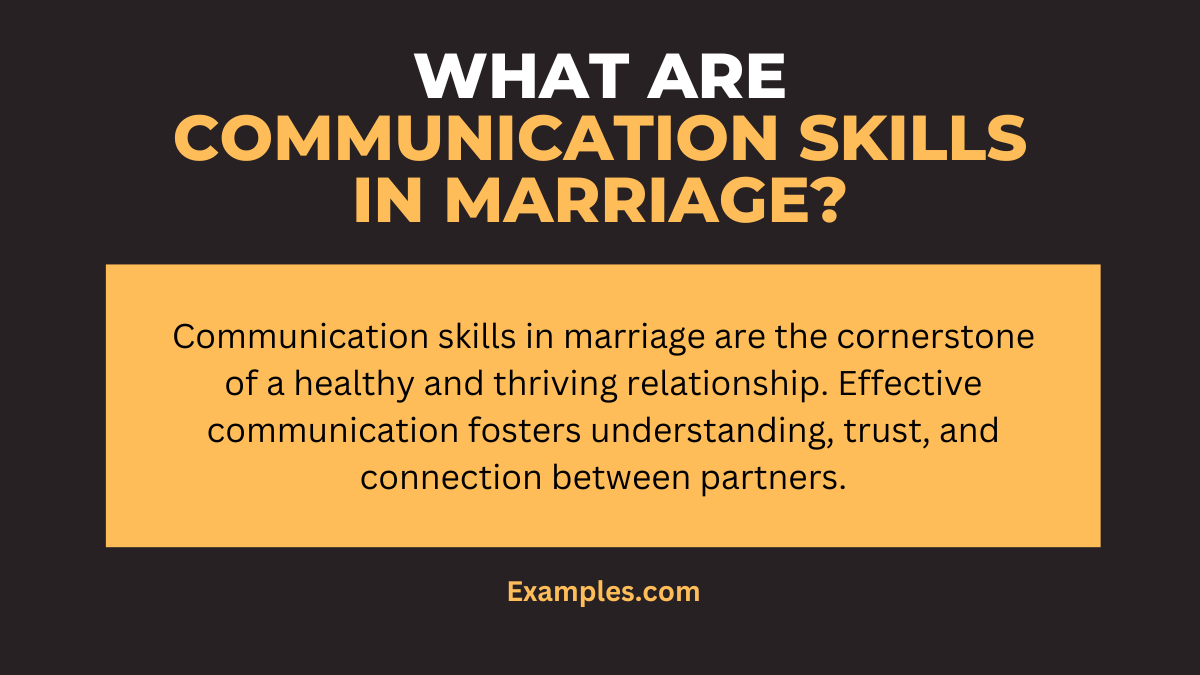Communication Skills in Marriage: Building a Stronger Bond

Communication skills in marriage are the cornerstone of a healthy and fulfilling relationship. A strong foundation of open and honest communication allows couples to navigate the ups and downs of life together, fostering intimacy, trust, and understanding. When communication flows freely, couples can express their needs and feelings clearly, resolve conflicts constructively, and deepen their emotional connection.
This guide explores the importance of effective communication in marriage, offering practical tips and strategies to enhance your communication skills. We will delve into active listening, expressing needs and feelings, resolving conflicts, and maintaining open communication over time. By developing strong communication skills, you can strengthen your bond, build a more loving and supportive partnership, and create a happier marriage.
The Importance of Communication in Marriage

Communication is the lifeblood of any successful relationship, and marriage is no exception. It is the foundation upon which intimacy, trust, and understanding are built. Effective communication allows partners to connect on a deeper level, navigate challenges together, and build a strong and lasting bond.
The Role of Communication in Fostering Intimacy
Open and honest communication is essential for creating and maintaining intimacy in a marriage. When couples communicate effectively, they can share their thoughts, feelings, and desires, fostering a sense of closeness and connection. This allows them to understand each other’s perspectives, appreciate each other’s strengths, and support each other’s growth.
The Importance of Communication in Building Trust
Trust is a cornerstone of any healthy relationship, and communication plays a crucial role in building and maintaining it. When partners are honest and transparent with each other, they demonstrate their trustworthiness. This creates a foundation of security and stability, allowing them to feel comfortable sharing their vulnerabilities and relying on each other for support.
Communication Breakdowns and Their Impact
Communication breakdowns can have a significant impact on a marriage, leading to conflict, misunderstandings, and dissatisfaction. When couples fail to communicate effectively, they may:
- Misinterpret each other’s intentions, leading to hurt feelings and resentment.
- Avoid difficult conversations, allowing problems to fester and grow.
- Resort to unhealthy communication patterns, such as blaming, criticizing, or withdrawing.
These communication breakdowns can create a rift between partners, making it difficult to resolve conflicts and maintain a sense of connection.
Examples of Communication Breakdowns Leading to Conflict
Imagine a couple where one partner expresses their desire for more quality time together. If the other partner does not fully listen or understand the message, they may respond defensively or dismissively. This can lead to a heated argument, leaving both partners feeling frustrated and misunderstood. Another example is when a partner expresses their feelings of dissatisfaction about a particular issue.
If the other partner fails to acknowledge or validate those feelings, it can create a sense of isolation and loneliness. This can lead to a breakdown in communication, making it difficult to address the underlying issues and find solutions.
Active Listening and Empathetic Understanding: Communication Skills In Marriage

Active listening is a fundamental skill in communication, particularly in marriage. It goes beyond simply hearing the words spoken; it involves truly understanding your partner’s perspective, emotions, and needs. This skill fosters a deeper connection and strengthens the bond between partners.
Active Listening Techniques
Active listening involves more than just sitting quietly while your partner speaks. It requires conscious effort and specific techniques to ensure you are truly understanding their message. Here are some key elements of active listening:
- Paraphrasing: Restate your partner’s message in your own words to ensure you have understood them correctly. This demonstrates that you are paying attention and encourages them to clarify if needed. For example, “So, what you’re saying is that you feel overwhelmed by the workload at home and need more support.”
- Summarizing: Briefly recapping the main points of your partner’s message to demonstrate that you have grasped the overall message. For instance, “You mentioned feeling stressed about your work deadlines and the upcoming family event. You’re looking for ways to manage your time better.”
- Asking Clarifying Questions: Asking questions to seek further information or understanding. This shows genuine interest and helps to avoid misunderstandings. For example, “Can you tell me more about what happened at work that made you feel so frustrated?”
Empathy and Understanding
Empathy is the ability to understand and share the feelings of another person. It involves stepping into your partner’s shoes and trying to see the situation from their point of view. This doesn’t mean you have to agree with their perspective, but it does require acknowledging and validating their feelings. To practice empathy and understanding, consider these techniques:
- Acknowledge their emotions: Start by recognizing and acknowledging your partner’s feelings. Phrases like “I can see you’re feeling upset,” or “It sounds like you’re frustrated” can help validate their emotions.
- Focus on their perspective: Try to understand the situation from their point of view, even if you don’t agree with it. Ask yourself, “What might be causing them to feel this way?” or “What experiences have shaped their perspective?”
- Avoid interrupting or judging: When your partner is speaking, resist the urge to interrupt or offer solutions prematurely. Give them space to express themselves fully without judgment.
Expressing Needs and Feelings Clearly
Open and honest communication is crucial for a healthy marriage. When couples can express their needs and feelings clearly, they create a safe space for understanding, empathy, and ultimately, a stronger bond.
Using “I” Statements
Effectively communicating your needs and feelings requires using “I” statements. This approach allows you to express your emotions without blaming or accusing your partner. By focusing on your own experience, you create a more constructive dialogue that fosters understanding and avoids defensiveness.
Here’s a breakdown of how to use “I” statements:
- Start with “I feel…”: This sets the tone for expressing your emotions, avoiding accusatory language.
- Describe the specific feeling: Use precise language to convey your emotions. For example, instead of saying “You make me angry,” say “I feel frustrated when…”
- Connect the feeling to a specific behavior: This helps your partner understand the source of your emotions and allows them to respond appropriately. For instance, instead of “You’re always late,” say “I feel anxious when you’re late because…”
“I feel hurt when you don’t call me back after promising to.”
Resolving Conflict Through Communication
Conflict is an inevitable part of any relationship, including marriage. While disagreements can be stressful, they also present opportunities for growth and strengthening the bond between partners. Effective communication is essential for navigating these conflicts constructively and reaching mutually agreeable solutions.
Conflict Resolution Strategies
Conflict resolution strategies are methods used to address disagreements in a constructive and productive manner. They focus on finding common ground, understanding each other’s perspectives, and working towards solutions that benefit both parties.
Common Conflict Resolution Techniques
- Active Listening: This involves paying full attention to your partner’s perspective, understanding their emotions, and acknowledging their feelings. It involves more than just hearing the words; it’s about truly understanding the message being conveyed. Benefits include:
- Improved understanding and empathy
- Reduced defensiveness and escalation
- Enhanced communication and trust
Drawbacks include:
- May be challenging for individuals who struggle with listening or patience
- Requires effort and focus, especially during heated moments
- Compromise: This involves both partners making concessions to reach a mutually agreeable solution. It requires a willingness to give and take, and to find a middle ground that meets the needs of both parties. Benefits include:
- Fair and equitable solutions
- Reduced power struggles and resentment
- Increased cooperation and collaboration
Drawbacks include:
- This may lead to feeling like one partner has given up more than the other
- Can be difficult to find a compromise that satisfies both parties fully
- Negotiation: This involves a structured process of discussion and bargaining to reach a mutually acceptable agreement. It often involves identifying common goals, exploring options, and making concessions to reach a win-win outcome. Benefits include:
- Structured and organized approach to resolving conflicts
- Focus on finding solutions that benefit both parties
- Increased likelihood of a mutually agreeable outcome
Drawbacks include:
- Can be time-consuming and requires patience
- May require both partners to be willing to compromise
- Problem-Solving: This involves identifying the root cause of the conflict and working together to find solutions. It focuses on finding practical solutions that address the underlying issues rather than focusing solely on the symptoms. Benefits include:
- Long-term solutions that address the core issues
- Increased understanding and collaboration
- Reduced likelihood of recurring conflicts
Drawbacks include:
- Can be challenging to identify the root cause of the conflict
- May require more time and effort than other strategies
Resolving Conflict Through Open Communication and Compromise
Open communication and compromise are crucial for resolving conflicts healthily and constructively. Here’s a step-by-step process to guide you:
Step-by-Step Process for Conflict Resolution
- Choose the Right Time and Place: Select a time and place where both partners feel comfortable and safe to talk openly. Avoid discussing sensitive issues when you are tired, stressed, or distracted.
- Start with “I” Statements: Use “I” statements to express your feelings and needs without blaming or accusing your partner. For example, instead of saying “You always forget to do the dishes,” try “I feel frustrated when the dishes are left undone.”
- Listen Actively: Pay attention to your partner’s perspective and acknowledge their feelings. Try to understand their point of view, even if you don’t agree with it.
- Focus on Finding Solutions: Instead of focusing on who is right or wrong, work together to find solutions that address both of your needs. Be open to compromise and consider different options.
- Agree on a Plan of Action: Once you’ve reached a solution, agree on a plan of action to implement it. This may involve specific tasks or changes that both partners need to make.
- Follow-up and Review: Check in with each other regularly to ensure that the plan is working and to make adjustments as needed. This helps to ensure that the solution is effective and sustainable.
Maintaining Open Communication Over Time

In the tapestry of a long-term marriage, communication is the thread that binds together the intricate patterns of love, understanding, and growth. While the initial spark of romance might ignite passionate conversations, sustaining open communication over time requires conscious effort and a commitment to nurturing the connection.
Just as a garden needs constant tending, so too does the garden of marital communication requires regular nourishment and attention.
Strategies for Fostering Ongoing Communication, Communication skills in marriage
Sustaining open communication in a long-term marriage involves cultivating a supportive and safe environment where both partners feel heard, understood, and valued. This can be achieved through various strategies that encourage regular and meaningful dialogue.
- Schedule Regular Check-Ins: Setting aside dedicated time for conversations, even if it’s just 15-20 minutes each day, can provide a structured space for sharing thoughts, feelings, and experiences. This routine fosters a sense of connection and ensures that communication doesn’t become a casualty of busy schedules.
- Engage in Active Listening: Active listening involves paying full attention to your partner’s words, both verbal and nonverbal, without interrupting or formulating your response. It demonstrates respect and understanding, creating a safe space for vulnerability and emotional connection. This can be enhanced by paraphrasing, asking clarifying questions, and reflecting on what you’ve heard.
- Embrace Vulnerability: Sharing your thoughts, feelings, and insecurities can deepen intimacy and strengthen the bond. While vulnerability can feel risky, it allows your partner to see the real you and fosters a sense of trust and authenticity in the relationship.
- Practice Gratitude and Appreciation: Regularly expressing gratitude for your partner’s presence and contributions can create a positive feedback loop, strengthening the emotional connection and encouraging open communication. Small gestures of appreciation, such as a handwritten note or a heartfelt compliment, can go a long way in nurturing a positive communication environment.
- Seek Professional Guidance: If communication challenges persist, seeking guidance from a marriage counselor or therapist can provide valuable tools and strategies for improving communication patterns and strengthening the relationship.
Potential Barriers to Open Communication
While fostering open communication is essential, certain barriers can hinder its flow. Recognizing these obstacles and developing strategies to overcome them is crucial for maintaining a healthy communication dynamic.
- Busy Schedules and Distractions: The demands of work, family, and other commitments can easily overshadow the importance of quality time together. Making a conscious effort to minimize distractions during conversations, such as putting away phones and turning off the TV, can create a more focused and attentive environment.
- Past Hurts and Resentments: Unresolved past hurts or resentments can create emotional walls that impede open communication. Addressing these issues, perhaps through therapy or open dialogue, is crucial for fostering a safe and trusting space for communication.
- Different Communication Styles: Partners often have different communication styles, which can lead to misunderstandings and misinterpretations. Recognizing and respecting these differences is essential for effective communication. For example, one partner might prefer direct and assertive communication, while the other might be more indirect and passive.Understanding these nuances can help bridge the gap and foster mutual understanding.
- Fear of Conflict: Avoiding conflict can seem like a way to maintain peace, but it often leads to resentment and unspoken issues that fester over time. Healthy communication involves the ability to navigate conflict constructively, express disagreements respectfully, and seek solutions together.
Activities to Encourage Regular Communication
Incorporating activities that encourage regular and meaningful communication can create a more connected and fulfilling relationship. These activities can be both fun and insightful, providing opportunities for deeper connection and understanding.
- Date Nights: Regular date nights, even if they’re just a simple dinner at home, provide a dedicated time for connection and conversation. Choosing activities that spark conversation, such as visiting a museum or attending a concert, can create shared experiences and generate topics for discussion.
- Journaling Together: Sharing personal thoughts and reflections through journaling can create a unique and intimate form of communication. This practice allows each partner to express themselves freely and authentically, fostering a deeper understanding of each other’s inner world.
- “State of the Union” Meetings: Holding regular “State of the Union” meetings, where you discuss the relationship and any issues that need attention, can create a structured space for open communication and problem-solving. These meetings can be scheduled monthly or quarterly, depending on your needs and preferences.
- Games and Activities: Playing board games, doing puzzles, or engaging in other shared activities can create a relaxed and fun atmosphere for conversation and connection. These activities can spark laughter, create shared memories, and provide a natural context for communication.
Seeking Help When Needed
It’s important to remember that seeking professional help is not a sign of weakness but rather a testament to your commitment to improving your relationship. Sometimes, even with the best intentions, couples may find themselves stuck in communication patterns that are difficult to break on their own.
Benefits of Seeking Professional Guidance
Seeking professional guidance from a therapist or counselor specializing in couples communication can offer significant benefits:
Objective Perspective: Therapists provide an objective perspective on your communication patterns, helping you identify blind spots and areas for improvement. They can offer valuable insights into your communication dynamics that you might not be aware of.
Skill Development
Therapists equip you with specific communication skills and techniques to address your unique challenges. These skills can help you express your needs more effectively, listen actively, and resolve conflicts constructively.
Improved Emotional Regulation
Therapy can help you learn to regulate your emotions during disagreements, preventing escalation and promoting healthier communication.
Strengthened Relationship
By improving your communication, you can build a stronger, more fulfilling relationship. Effective communication fosters understanding, intimacy, and a sense of connection.
Resources for Couples
There are numerous resources available for couples seeking communication skills training or counseling:*
Marriage and Family Therapists: These professionals specialize in helping couples improve their communication and resolve relationship issues.
Licensed Professional Counselors
These professionals can provide counseling and therapy for a range of relationship challenges, including communication difficulties.
Couples Workshops and Retreats
These intensive programs offer couples the opportunity to learn communication skills and improve their relationship in a supportive environment.
Online Resources
Many websites and apps offer communication tips, exercises, and resources for couples.
How Therapy Can Help
Therapy can help couples improve their communication in various ways:
Identifying Communication Patterns: Therapists help couples identify recurring patterns of communication, such as defensiveness, stonewalling, or blaming.
Developing Communication Skills
Therapists teach couples specific communication skills, such as active listening, assertive communication, and conflict resolution techniques.
Improving Emotional Regulation
Therapists help couples learn to manage their emotions effectively during disagreements, preventing escalation and promoting constructive dialogue.
Building Trust and Intimacy
By improving communication, couples can build stronger trust and intimacy, fostering a deeper connection.
“Therapy can help couples learn to navigate disagreements in a way that strengthens their relationship rather than weakens it.”Dr. John Gottman, renowned relationship expert.
Ending Remarks
Mastering communication skills in marriage is an ongoing journey, requiring commitment and effort from both partners. By prioritizing open and honest communication, actively listening to each other, and working together to resolve conflicts, you can create a foundation for a strong and lasting marriage.
Remember, communication is the lifeblood of a healthy relationship, and by nurturing it, you can cultivate a love that endures.
Comments are closed.